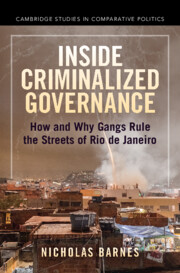Book contents
- Inside Criminalized Governance
- Cambridge Studies in Comparative Politics
- Inside Criminalized Governance
- Copyright page
- Dedication
- Contents
- Figures
- Tables
- Acknowledgments
- A Note on Translation
- Abbreviations, Acronyms, and Translated Words
- 1 Introduction
- 2 Criminalized Governance
- 3 A Theory of Criminalized Governance
- 4 The Origins of Criminalized Governance
- 5 Comando Vermelho of Nova Holanda
- 6 Comando Vermelho of Parque União
- 7 Terceiro Comando (Puro) of Complexo da Maré
- 8 Criminalized Governance during Military Occupation
- 9 Conclusion
- 10 Epilogue
- Appendices
- References
- Index
- Other Books in the Series (continued from page ii)
7 - Terceiro Comando (Puro) of Complexo da Maré
Published online by Cambridge University Press: 06 February 2025
- Inside Criminalized Governance
- Cambridge Studies in Comparative Politics
- Inside Criminalized Governance
- Copyright page
- Dedication
- Contents
- Figures
- Tables
- Acknowledgments
- A Note on Translation
- Abbreviations, Acronyms, and Translated Words
- 1 Introduction
- 2 Criminalized Governance
- 3 A Theory of Criminalized Governance
- 4 The Origins of Criminalized Governance
- 5 Comando Vermelho of Nova Holanda
- 6 Comando Vermelho of Parque União
- 7 Terceiro Comando (Puro) of Complexo da Maré
- 8 Criminalized Governance during Military Occupation
- 9 Conclusion
- 10 Epilogue
- Appendices
- References
- Index
- Other Books in the Series (continued from page ii)
Summary
The third of Maré’s gangs, Terceiro Comando Puro (TCP), controls an enormous territory, encompassing ten contiguous neighborhoods with an estimated population of 68,000 residents, more than twice that of Maré’s Comando Vermelho-connected gangs. Moreover, TCP’s turf has changed significantly over time as the gang has lost and won territory through violent battles with several rivals, which have had horrifying consequences for both gang members and residents. This chapter also shows how the nature of enforcement against gangs can shift radically as TCP developed highly collaborative relations with the police especially after 2009. The chapter traces these developments in TCP’s historic territories as well as the housing projects that they would control from the mid-1990s until 2002 and again after 2009. This chapter interweaves multiple types of data, including eighteen months participant observation, dozens of interviews with current and former gang members and residents, as well as journalistic accounts and denunciations to an anonymous hotline, to trace how TCP’s shifting security environment has shaped their governance practices over time.
Keywords
- Type
- Chapter
- Information
- Inside Criminalized GovernanceHow and Why Gangs Rule the Streets of Rio de Janeiro, pp. 205 - 242Publisher: Cambridge University PressPrint publication year: 2025

